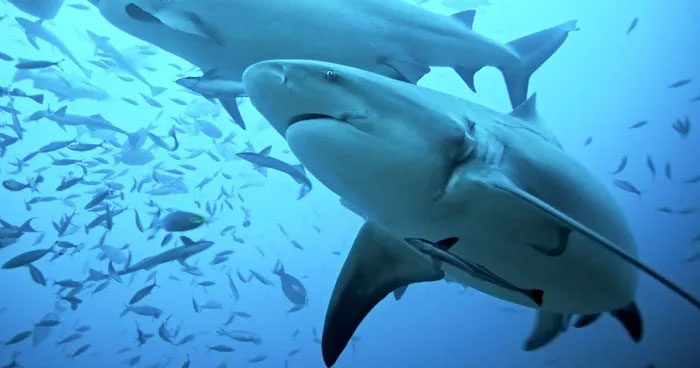The impacts of ocean warming are profound and well-documented. However, sometimes changes in wind patterns and ocean currents can lead to counterintuitive consequences.
It is hard to believe that while Earth is warming day by day, there are reverse effects in some sea regions: Surface temperatures can drop rapidly—by 10°C or more in just one or two days. When these conditions persist for several days or weeks, the area experiences a “cold wave,” contrasting with the familiar heatwaves at sea.
When a “deadly cold wave” occurred along the southeast coast of South Africa in March 2021, it resulted in the deaths of hundreds of animals from at least 81 species. Even more concerning is that these fatalities included vulnerable species. In southern Africa, bull sharks (or white-eyed bull sharks), whale sharks, and rays have died en masse after such unexpected cold spells, especially in the past 15 years.
In the journal Nature Climate Change, two scientists, Nicolas Benjamin Lubitz – a marine ecology researcher at James Cook University, and David Schoeman – a professor of Global Change Ecology at the University of Sunshine Coast, asserted that conditions leading to these deadly cold spells have become increasingly common over the past four decades.
The consequences could threaten even highly mobile species like sharks.

Mass deaths of bull sharks due to cold.
What is happening?
Certain wind and ocean current conditions can cool sea surface temperatures instead of warming them. This occurs when winds and currents push coastal waters offshore, allowing cold water from the depths of the ocean to rise and replace it. This process is known as upwelling.
In some areas, such as along the California coast in the western United States, cold water rises regularly due to upwelling occurring along hundreds of kilometers of coastline. However, localized upwelling can also occur seasonally on a smaller scale, often at the edges of bays along the eastern continental coast due to interactions between winds, currents, and shorelines.
Previous research has shown that climate change is causing shifts in global wind and current patterns. Therefore, the two scientists investigated the potential consequences at specific locations by analyzing long-term temperature and wind data along the southeast coast of South Africa and the eastern coast of Australia.
This revealed an increasing trend in the number of cold upwelling events annually over the past 40 years. They also noted an increase in the intensity of such cold upwelling events and the degree of temperature drop on the first day of each upwelling event. In other words, these coastal cooling events are becoming more severe and abrupt.
Investigating mass mortality events
During the extreme cold upwelling event along the southeast coast of South Africa in March 2021, at least 260 animals from 81 species died. To investigate the classification concerning the marine fauna, the two scientists took a closer look at bull sharks. They attached tracking devices to the sharks to record depth and temperature.
Bull sharks are a tropical species with high migratory tendencies, typically moving to upwelling areas only during warmer months. As winter begins, they migrate back to warmer tropical waters. As highly mobile animals, they could potentially avoid localized cold temperatures. So why are bull sharks among the species affected in this extreme cold upwelling event?
When fleeing is not enough
Bull sharks can survive in environmental conditions that most other marine organisms cannot adapt to. For example, they are often found in rivers hundreds of kilometers away from the sea, where other marine creatures do not dare to venture.
Tracking data from the scientists in both South Africa and Australia indicates that bull sharks actively avoid cold upwelling areas during their seasonal migrations, even when the upwelling is not significant. Some shark species take refuge in shallow, warmer bays until sea surface temperatures rise again. Others stay close to the surface, where the water is warmest, swimming as fast as possible to escape the rising cold water.
However, if cold waves at sea continue to rise suddenly and more violently, fleeing or hiding may no longer be safe for them. For instance, during the event in South Africa that caused the deaths of rays and bull sharks, water temperatures dropped from 21°C to 11.8°C in less than 24 hours while the weather event lasted for seven days.
This sudden, severe drop combined with the prolonged duration makes this localized cold weather event particularly dangerous. If future weather events continue to worsen, mass mortality among marine organisms could become more common, especially along the eastern coast in areas with mid-latitude.
Still figuring out how climate change will unfold
Overall, the oceans are warming. The ranges of tropical and subtropical species are expanding towards the poles. However, due to the effects of upwelling, sudden cooling in a short time can pose challenges for migratory species. Even the most resilient organisms may be vulnerable to the impacts of localized cold.
While we see the overall trend of Earth warming, current weather and morphological changes can also lead to extreme localized cold phenomena. This truly highlights the complexity of climate change, as tropical species will expand into higher latitude areas as warming continues, putting them at risk of dying when faced with sudden localized cold. Thus, species like bull sharks and whale sharks are likely struggling in their seasonal migrations.
The urgency to mitigate our human impact on the planet by reducing greenhouse gas emissions, as well as the need to research what may happen in the future, is increasingly pressing.


















































